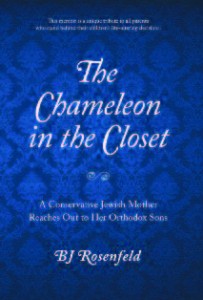The Chameleon in the Closet
 The Chameleon in the Closet
The Chameleon in the Closet
By BJ Rosenfeld
2010226 pages
Reviewed by Jack Abramowitz
I rarely read memoirs. So what are my credentials for reviewing The Chameleon in the Closet? As a teen, I became more religious than my family, and over the years, I was privileged to observe many such religious transformations through my decades of work with NCSY. In The Chameleon in the Closet, author BJ Rosenfeld shares a different perspective on the ba’al teshuvah: that of the nonobservant parent.
At times accommodating, other times exasperated, Rosenfeld ultimately does succeed in “shepping Yiddishe nachas” from her two sons who have chosen an Orthodox lifestyle, her daughters-in-law and her many “frum– from-birth” grandchildren.
The Chameleon in the Closet should be required reading for any teen or young adult undergoing religious transformation. This will not discourage them in any way, because the book in no way undermines such pursuits. What it does is facilitate empathy for what the parents of such young people might be going through.
Not unexpectedly, Rosenfeld does encounter bumps on her sons’ road to Orthodoxy ranging from molehills (extending her hand upon meeting a rabbi and being rebuffed) to veritable mountains (coping with a child in Israel during the Intifada). Of course, kashering the house and preparing Pesach for children who have become frum can be daunting and occasionally bewildering for even the most cooperative of parents.
Rosenfeld’s emotions run the gamut throughout the book. She also experiences flashbacks to her childhood and her Orthodox grandparents. (As she learns more about Jewish law through her sons, it dawns on her that perhaps her grandfather was not quite as observant as she had thought. And if cholent is the cornerstone of Shabbat lunch, as her son says, why had her grandmother never made it?)
Rosenfeld also learns that the Orthodox are not as sheltered as she had previously assumed, and she does not hesitate to correct many of her friends’ misconceptions. She comes to such conclusions as, “Every so often Peter [her husband] reminds me how lucky we are to have Jewish grandchildren when so many of our Jewish friends do not because their children married non-Jews. So what if Yehuda and Chaim [her sons] don’t want me cooking on Shabbat?” Her perspective is admirable and, sadly, her realization about assimilation all too common.
Neither son owns a television. “Would it be possible to find appropriate programs for our grandchildren to watch?” Rosenfeld asks. “Absolutely. But I’d never do that unless I had the parents’ permission.” How refreshing to hear that! If only more grandparents—even those who share their children’s lifestyles—honored the parents’ wishes like that!
It’s noteworthy that Rosenfeld’s two sons took paths that diverge somewhat from each other. Yehuda, who is “ultra-Orthodox,” “believes in adhering to all the rules to the nth degree,” Rosenfeld writes, while Chaim, who is Modern Orthodox, “believes that some are open to interpretation.” The result is that “Chaim’s brand of Orthodoxy is much easier . . . to deal with.” While Rosenfeld tries to accommodate both sons’ religious needs, Chaim occasionally calls his older brother to task for what he views as unnecessary stringencies, be it concerning the kashrut of hydroponic lettuce or their parents’ usage of the Internet.
The author is somewhat preoccupied with her wardrobe (note the title of the book). What does she wear when visiting her son in Israel? When meeting prospective in-laws? To a vort (engagement party)? What was the mother of the bride wearing? What was the rebbetzin wearing? While I found it a little hard to relate to her fashion concerns, her apprehensions about her clothing do shed light on the anxieties one might experience when placed in a strange environment with unfamiliar expectations.
One must remember that this is first and foremost a book of Rosenfeld’s experiences and perspectives; thus, the occasional error about Jewish law and practice must be taken in that context. The Talmud, for example, does not include the text of the Torah, as posited on page twenty-eight. A statement on page five about seafood not being kosher is clarified only later, limiting it to shellfish. Such glitches are few and far between, far outweighed by the breadth of knowledge and understanding Rosenfeld has acquired for a lifestyle she has not personally chosen to adopt. “Though we never set out to raise a Talmudic scholar, that doesn’t mean there’s anything wrong with Yehuda turning out that way,” Rosenfeld writes. Or, as she puts it elsewhere, “I had come to realize that there are far worse things than having Orthodox sons.” These statements may seem like less than stellar praise, but there are so many young people who crave such validation. The Chameleon in the Closet shares both the parents’ challenges and their pride. Ultimately, the latter makes the former worth enduring.
Rabbi Jack Abramowitz is the editor of OU Torah (www.outorah.org). He is the author of five books, including The Tzniyus Book (2009) and The Taryag Companion (2012).
Listen to author BJ Rosenfeld discuss her book at ou.org/closet.
